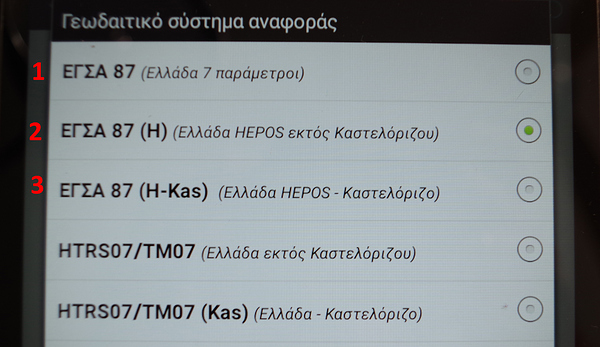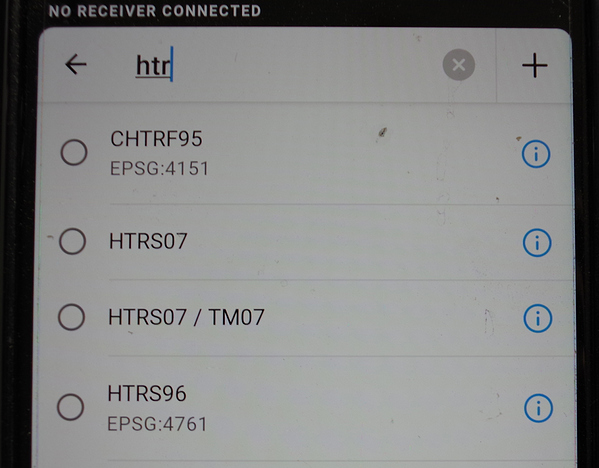As an archaeological surveyor working in Greece I am very delighted that the transformation to the Hellenic geodetic system, according to the Hepos Grid (Hepos/GGRS87/TM87) is now available in the ReachView3 App, version 6.3 (released on the 13th of July). I have tested the accuracy of the transformations against other software that I have used in the past (Mobile Topographer, Survey Master) and the results are virtually coincidental. This new addition makes the ReachView3 app fully functional for users based in Greece and I am sure that the sales of Emlid Reach RS2 in this country will be drastically increased. I wish to express my compliments to the staff of Emlid for this.
Hi Evangelos,
Thanks for your feedback! ![]()
I believe you should have a lot of interesting projects to share, so it’d be great if you have time to post some photos here!
I experienced some lagging-freezing when I set the GGRS87/HEPOS system. The lagging-freezing happened when i collected some points. The old GGRS87 works like before.
Also the export to csv had some strange issues between the systems. The Hepos system exports correctly but the old GGRS87 exports far far away from the correct location.
I am on dev firmware though and tested with M2 and helical antenna. I don’t know if this has to do with it.
I have experienced some lagging issues with Hepos/GGRS87 when running the ReachView3 app on a Samsung Galaxy tablet (Tab 295).
However, the application runs smoothly in a Xiaomi Mi-8 Lite Smartphone.
Perhaps there are compatibility issues with specific devices? In what device have you run the app?
Regarding your second point, I have experienced similar misplacements when experimenting with the old GGRS87 system. The coordinates I have got were more than 300 off. The problem is not limited in the ReachView3 app, since I have got similar wrong results with Apglos Survey Wizard. Obviously, it all has to do with the application of wrong tranformation parameters from WGS84 to GGRS87.
Dear Tatiana, I intend to post some photos from the field in the near future, and also share data from my projects
Hi @vgo195, @e_kroustalis,
Oh, sounds like something we should look into. We haven’t experienced it during testing on our devices here, so if you share the screencast of such behavior, it would be of great help.
@vgo195, on which device have you faced the issue with lagging? Is it an Android or iOS device? We have to know the exact model to investigate.
We would like to investigate it, too. To look into these misplacements, we need at least 3 points with known coordinates collected in ReachView 3 in this coordinate system. It helps us to compare the difference and check why it happens.
Samsung J5 Android device here.
It is a bit old device but hadn’t issues before.
OK, thanks for the info! @kseniia.suzdaltseva will continue troubleshooting it with you and get back to you once we have any updates or additional questions.
I believe that trying to solve issues related to GGRS87 (EPSG 2100) would be a waste of time, given that this datum tends to be obsolete. It was superseded since 2009 by Hepos/GGRS87, which produces more accurate and consistent results. The realization of Hepos/GGRS87 is much more delicate, since it is based on a two-steps proccess (1. Application of the Helmert 7 parameters transformation for the whole of Greece. 2. Application of further 2D corrections according to the Hepos grid to cope with local movements of the earth surface due to tectonic activity). However, if you still want some measurements in GGRS87 (EPSG 2100) juxtaposed to measurements of the same points in Hepos/GGRS87, I can post them in the near future.
Hi Evangelos,
Thanks for the clarifications!
Each country has its own rules on the coordinate systems, and it’s always big detective work to get down to them.
I’ve just discussed this case with our GIS developers, as it seemed suspicious to me. And it’s indeed happened to be a tricky one — and consistent with your comment.
At the moment, we have 2 different GGRS87 datums in ReachView 3: GGRS87 and GGRS87 Approx.
- GGRS87 Approx datum is the target datum we got after 7-parameters Helmert transformation
- GGRS87 datum is the target datum on which both Helmert transformation and HEPOS horizontal grid applied
We initially thought that, in most cases, our users would need to work with the datum after the grid application. So, to work with the target datum without the HEPOS grid, you can choose GGRS87 Approx in ReachView 3.
Looks like the current naming is misleading. We’ll work on making it more precise.
Dear Tatiana,
leaving the matter of terminology aside, with the recent additions that you have done in version 6.3 of ReachView3 app, you have solved the major issues of coordinates transformations in Greece. I can verify that Hepos/GGRS87/TM87 (= Helmert 7 parameters transformation + Hepos Grid 2D corrections) is the datum that is used by NTRIP correction services, like HEPOS and HxGN Smartnet (I have bought a subscription in SmartNet).
Besides, perhaps the following image, which I have extracted from the Coordinates Section of Mobile Topographer, is of interest to you.
The following options are offered:
- GGRS87 (Greece 7 Parameters) = ReachView3 GGRS87 Approx.
- GGRS87 (H) (Greece Hepos, Kastelorizo excluded) = ReachView3 GGRS87/HEPOS.
- GGRS87 (H-Kas) (Greece HEPOS – Kastelorizo).
Note: Kastelorizo is a remote island to the SE of Mainland Greece, in whose area different transformation parameters are applied.
Apart from the above, GGRS87 (EPSG 2100) is to be found in ReachView3 App (for details see: GGRS87 / Greek Grid - EPSG:2100). This is the datum that was commonly used between 1990 and 2009. Its realization was based on three parameters, but its use is no more recommended in modern practice.
Let me again thank you and your collaborators for the great job you have done with the Emlid products and ReachView3 app!
Hi Evangelos,
Yeah, since the new-added CS works properly, the terminology is not that important. But we want everything to be consistent and straightforward, so we’d either change naming or remove the obsolete CS from the list at all.
You owe us the photos now! ![]()
Please, do not remove anything from the list; some people may still want to use the old system
I agree, some projects still require the old system bound with the official benchmarks.
So it is better to have 3 systems, the old GGSR87 the new HEPOS/GGRS87 with the grid files and it would be nice to add the HTRS07/TM07 which is the latest system.
Hi guys,
I created a project in GGRS87 / Hepos with the Greece GREEKGEOID2010 height and noticed some lagging on our Android devices as well. I’ve passed all the information to the team for further investigation. If there’s any news or we need additional details from you, I’ll write back.
Thank you very much,
Kseniia,
your contribution is very important for many people working in Greece, who are already using or are interested in using ReachRs2 receivers
Hey there,
We fixed the naming in the last ReachView 3 update.
The GGRS87 datum is now the target datum we got after the 7-parameters Helmert transformation (as was suggested by @e_kroustalis), and the GGRS87 Approx datum no longer exists to not mislead anyone.
Hi,
I tested the latest RV3 with the GGRS87/HEPOS projections and the app froze while pressing the (+) button to record a point. I tried various combinations with and without the greek hepos geoid file. Sometimes it didn’t froze but certainly there is a bug. The coordinates are correct though compared to other apps like SurPad.
Hi @vgo195,
Thanks for sharing your observations! We are in the process of testing GGRS87/HEPOS as well. I’ll describe our results here.






